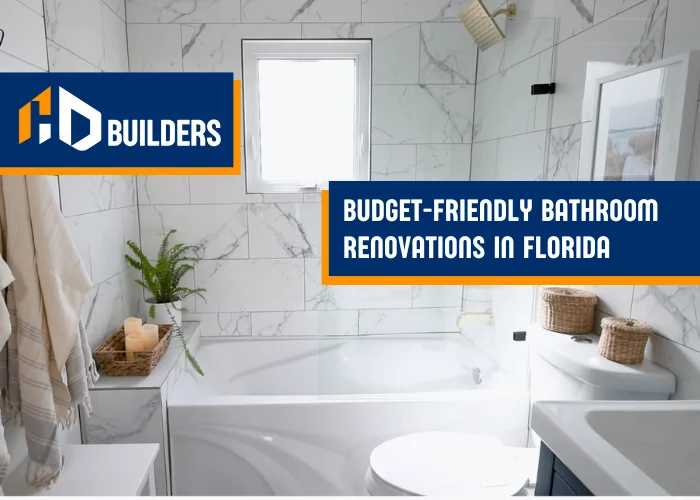Are you dreaming of a bathroom renovation but worried about the cost? You’re not alone. Many homeowners in Florida face the challenge of wanting to update their bathrooms without breaking the bank. The good news is that with careful planning and smart choices, you can achieve a stunning bathroom makeover without blowing your budget. In this blog post, we’ll explore budget-friendly bathroom renovation ideas tailored specifically for Florida homes. From assessing your budget to choosing cost-effective materials and incorporating DIY projects, we’ll cover everything you need to know to turn your bathroom into a stylish oasis without breaking the bank.
Table of Contents:
- Assessing Your Budget
- Planning Your Renovation
- Choosing Cost-Effective Materials
- DIY vs. Hiring Professionals
- Maximizing Space and Functionality
- Incorporating Energy-Efficient Solutions
- Adding Personal Touches
- Maintaining Budget Throughout the Renovation Process
- Conclusion
Assessing Your Budget:
When embarking on a renovation project, one of the first steps is to assess your budget. This crucial task sets the foundation for the entire project and ensures that you stay on track financially. Here’s what you should consider when it comes to effectively assess your budget for a renovation project:
- Start by Listing Your Must-Have Upgrades: Take some time to envision your ideal renovation outcome. What are the key upgrades or changes you want to make to your space? Whether it’s updating outdated fixtures, expanding the layout, or enhancing functionality, list down your must-have upgrades to guide your budgeting process.
- Allocate Funds Accordingly: Once you have a clear list of must-have upgrades, allocate funds to each item on your list. Consider factors such as the cost of materials, labor, permits, and any additional expenses that may arise during the renovation process. Be sure to set aside a contingency fund for unexpected costs.
- Be Realistic About What You Can Afford: It’s important to be realistic about your budget limitations. While it’s tempting to aim for extravagant upgrades, it’s essential to prioritize essentials and allocate funds accordingly. Consider what you can comfortably afford without straining your finances or going into debt.
- Prioritize Essentials to Avoid Overspending: To avoid overspending, prioritize essential upgrades that align with your needs and goals. Focus on areas that require immediate attention or offer the most value in terms of functionality and aesthetics. You can always tackle non-essential upgrades in the future as your budget allows.
- Research Cost Estimates: Before finalizing your budget, research the cost estimates for materials, labor, and other expenses associated with your renovation project. Get quotes from multiple contractors or suppliers to ensure that you’re getting competitive pricing and accurate estimates.
- Factor in Contingency Funds: No renovation project is without unexpected surprises or additional costs. To account for these unforeseen expenses, allocate a contingency fund of around 10-20% of your total budget. Having a buffer will give you peace of mind and flexibility to address any issues that may arise during the renovation process.
- Consider Financing Options: If your budget falls short of covering the cost of your renovation project, consider exploring financing options such as personal loans, home equity loans, or lines of credit. However, be mindful of the interest rates and repayment terms associated with each option to ensure that it aligns with your financial goals.
- Seek Professional Advice: If you’re unsure about how to assess your budget or allocate funds for your renovation project, don’t hesitate to seek professional advice. Consult with a reputable contractor, interior designer, or financial advisor who can provide valuable insights and guidance based on your specific needs and circumstances.
Planning Your Renovation:
Effective planning is key to a successful bathroom renovation. Evaluate your current bathroom layout, research design ideas, and create a detailed plan outlining your renovation goals and timeline.
- Assessing Your Current Layout: Before diving into a renovation project, take a close look at your existing bathroom layout. Identify what works well and what areas could be improved. Consider factors like functionality, storage, and aesthetics to determine the changes you want to make.
- Research Design Ideas: Gather inspiration from various sources to inform your renovation plans. Browse through home improvement magazines, websites, and social media platforms for design ideas and trends. Take note of elements you like and incorporate them into your vision for your renovated bathroom.
- Creating a Detailed Plan: Once you have a clear idea of your renovation goals, it’s time to create a detailed plan. Outline the specific changes you want to make, such as updating fixtures, replacing flooring, or reconfiguring the layout. Set a realistic timeline for the project, considering factors like construction time and availability of contractors.
- Setting a Realistic Budget: Budget considerations are crucial when planning a renovation. Determine how much you’re willing to spend and allocate funds accordingly. Research the cost of materials, labor, and any additional expenses to ensure your budget aligns with your renovation goals.
- Hiring Professional Help: Depending on the scope of your renovation, you may need to hire professionals such as contractors, plumbers, or electricians. Research reputable professionals in your area and obtain quotes for their services. Be sure to check references and credentials before making a decision.
- Considering DIY Options: For smaller projects or those with a limited budget, consider tackling some aspects of the renovation yourself. DIY projects like painting, installing new fixtures, or updating hardware can help save on labor costs. However, be realistic about your skills and abilities to avoid costly mistakes.
- Selecting Materials and Finishes: Choose materials and finishes that not only fit your budget but also align with your design aesthetic and lifestyle. Explore cost-effective options like laminate countertops, vinyl flooring, and fiberglass showers that offer durability and style without breaking the bank.
- Maximizing Space and Storage: Optimize the use of space in your bathroom by incorporating smart storage solutions. Consider adding built-in shelving, medicine cabinets, or recessed niches to maximize storage without sacrificing floor space. Utilize vertical storage options to make the most of limited square footage.
- Preparing for the Unexpected: Renovation projects often come with unforeseen challenges or setbacks. Be prepared for unexpected issues like plumbing leaks, structural issues, or delayed deliveries. Build some flexibility into your timeline and budget to accommodate any surprises that may arise.
- Communicating Your Vision: Effective communication with your contractors and designers is essential throughout the renovation process. Clearly convey your renovation goals, preferences, and expectations to ensure everyone is on the same page. Regularly communicate with your team to address any concerns or questions that may arise.
Choosing Cost-Effective Materials:
When embarking on a bathroom renovation project, selecting cost-effective materials is crucial to achieving a beautiful result without breaking the bank. Here’s how to choose materials that balance affordability with durability and style:
- Porcelain Tiles: Porcelain tiles are an excellent choice for bathroom flooring and walls. They are durable, water-resistant, and come in a wide range of colors, patterns, and sizes. Look for affordable options that mimic the look of more expensive materials like marble or stone.
- Laminate Countertops: For a budget-friendly countertop option, consider laminate. Laminate countertops are available in various colors and patterns, including designs that resemble natural stone or wood. They are easy to clean, resistant to stains and scratches, and more affordable than materials like granite or quartz.
- Prefabricated Vanities: Prefabricated vanities are pre-assembled units that come with a countertop, sink, and sometimes a faucet included. These ready-to-install vanities are typically more affordable than custom-built options and offer a quick and easy solution for updating your bathroom.
- Shop for Deals and Discounts: Take advantage of sales, promotions, and discounts when shopping for materials. Many home improvement stores offer seasonal sales or clearance events where you can find quality materials at discounted prices. Additionally, consider shopping online or at outlet stores for discounted products.
- Comparison Shopping: Don’t settle for the first option you come across. Take the time to compare prices and quality across different retailers and suppliers. Look for products that offer the best value for your money, considering factors like durability, warranty, and customer reviews.
- Consider Alternative Materials: In addition to traditional materials like porcelain tiles and laminate countertops, consider alternative options that offer cost savings without sacrificing quality. For example, luxury vinyl flooring is a durable and budget-friendly alternative to hardwood or ceramic tile flooring.
- DIY Installation: If you’re handy and willing to put in some elbow grease, consider tackling the installation yourself to save on labor costs. However, be sure to research proper installation techniques and tools needed to ensure a professional-looking result.
- Focus on High-Traffic Areas: Prioritize spending on materials for high-traffic areas like flooring and countertops, where durability is essential. Allocate your budget strategically to invest in quality materials that will withstand daily wear and tear.
- Maximize Savings: Look for ways to maximize savings without compromising on quality. Consider purchasing materials in bulk or opting for slightly imperfect items at discounted prices. Additionally, inquire about volume discounts or package deals when purchasing multiple items from the same supplier.
- Quality Over Quantity: While it’s essential to stick to your budget, avoid sacrificing quality for the sake of saving money. Investing in durable, high-quality materials may cost more upfront but can save you money in the long run by reducing the need for repairs and replacements.
DIY vs. Hiring Professionals:
When embarking on a renovation project, one of the crucial decisions to make is whether to handle certain tasks yourself or enlist the help of professionals. While DIY projects can be enticing for their cost-saving potential, there are several factors to consider before diving in.
- Assessing Your Skills and Abilities: Before deciding on DIY or hiring professionals, honestly evaluate your skills and abilities. Are you experienced in the tasks required for the renovation, such as plumbing, electrical work, or carpentry? Consider whether you have the necessary tools, knowledge, and expertise to complete the job safely and effectively.
- Complexity of the Project: Consider the complexity of the renovation project when weighing the DIY option. While painting walls or installing shelves may be relatively straightforward DIY tasks, more complex projects like plumbing or electrical rewiring require specialized skills and knowledge. Attempting tasks beyond your expertise could lead to costly mistakes or safety hazards.
- Time and Convenience: DIY projects often require a significant time commitment, especially if you’re learning new skills along the way. Consider whether you have the time to dedicate to the project, taking into account your work schedule, family obligations, and other commitments. Hiring professionals can save you time and hassle by completing the project efficiently and with minimal disruption to your daily life.
- Cost Considerations: While DIY projects can save money on labor costs, it’s essential to weigh the potential cost savings against the risks and challenges involved. Factor in the cost of materials, tools, permits, and any potential mistakes or rework required. In some cases, hiring professionals may be more cost-effective in the long run, especially for complex or time-consuming projects.
- Quality and Safety: One of the primary advantages of hiring professionals is the assurance of quality and safety. Experienced contractors have the skills, knowledge, and equipment to complete the job to high standards, minimizing the risk of errors or accidents. They also adhere to building codes and safety regulations, ensuring compliance and peace of mind.
- Consulting with Experts: If you’re unsure whether to tackle a task yourself or hire professionals, consider consulting with experts in the field. Seek advice from contractors, plumbers, electricians, or other professionals to assess the feasibility of DIY and the potential risks involved. They can offer valuable insights and recommendations based on their expertise.
- Combining DIY and Professional Services: In some cases, a combination of DIY and professional services may be the most practical approach. You could handle simpler tasks yourself while hiring professionals for more complex or specialized work. This hybrid approach allows you to save money on labor costs while ensuring the quality and safety of critical aspects of the renovation.
- Considering Long-Term Impacts: Finally, consider the long-term impacts of your decision. While DIY projects may offer immediate cost savings, poorly executed work could lead to costly repairs or renovations down the line. Investing in professional services ensures quality results that stand the test of time, enhancing the value and enjoyment of your home for years to come.
Maximizing Space and Functionality:
When it comes to bathroom renovations, optimizing space and functionality is essential, especially in smaller or compact bathrooms. By incorporating clever storage solutions and efficient layout designs, you can make the most of your bathroom space while ensuring it remains functional and practical for your needs.
- Utilize Wall-Mounted Storage: One effective way to maximize space in a bathroom is by utilizing wall-mounted storage solutions. Consider installing wall-mounted cabinets or shelves above the toilet or vanity area to take advantage of vertical space. These storage units can provide valuable storage space for toiletries, towels, and other bathroom essentials without encroaching on floor space.
- Explore Corner Fixtures: In bathrooms with limited square footage, corner fixtures can be a game-changer. Consider installing a corner sink or vanity to make use of underutilized corner space while maintaining a functional layout. These compact fixtures help free up valuable floor space, making the bathroom feel more open and spacious.
- Invest in Multifunctional Fixtures: Another strategy for maximizing space and functionality is to invest in multifunctional fixtures. Look for fixtures that serve dual purposes, such as a combination shower and bathtub unit or a toilet with built-in storage shelves or a bidet feature. These multifunctional fixtures not only save space but also add convenience and versatility to your bathroom.
- Opt for Space-Saving Layouts: When planning your bathroom renovation, consider space-saving layout designs that maximize efficiency. For example, opt for a walk-in shower with a glass enclosure instead of a traditional bathtub to free up floor space. Alternatively, choose a wall-hung toilet to create a more open and airy feel in the bathroom.
- Incorporate Built-In Storage: Built-in storage solutions can also help maximize space and functionality in the bathroom. Consider integrating recessed shelves or niches into the shower or bath area to store toiletries and bath essentials. Additionally, incorporate built-in cabinets or drawers beneath the vanity to provide additional storage without cluttering the space.
- Use Mirrors to Create Illusion of Space: Strategic use of mirrors can make a small bathroom feel larger and more spacious. Install a large mirror above the vanity to reflect light and visually expand the room. Consider incorporating mirrored cabinet doors or mirrored tiles to further enhance the illusion of space.
- Optimize Layout for Traffic Flow: When designing your bathroom layout, pay attention to traffic flow and accessibility. Ensure that there is enough clearance around fixtures and that doors and drawers can open and close freely without obstruction. A well-planned layout will not only maximize space but also enhance usability and convenience.
- Consider Customized Storage Solutions: For bathrooms with unique layouts or specific storage needs, consider customizing storage solutions to maximize space and functionality. Work with a professional designer or carpenter to create customized built-in cabinets, shelving units, or storage nooks that are tailored to your space and requirements.
- Embrace Minimalist Design: Finally, embrace minimalist design principles to keep the space feeling open and uncluttered. Avoid overcrowding the bathroom with unnecessary decor or accessories, and opt for sleek, streamlined fixtures and finishes. A minimalist approach will help create a sense of openness and tranquility in the space while maximizing functionality.
Incorporating Energy-Efficient Solutions:
When embarking on a bathroom renovation project, incorporating energy-efficient solutions can not only help save on utility bills but also reduce your environmental footprint. By choosing energy-efficient fixtures and appliances, you can enjoy long-term savings while contributing to a more sustainable home. Here are some tips for incorporating energy-efficient solutions into your bathroom renovation:
- Opt for Water-Saving Fixtures: Water-saving fixtures, such as low-flow faucets, showerheads, and toilets, are designed to minimize water usage without sacrificing performance. These fixtures reduce water consumption by limiting flow rates, allowing you to conserve water and lower your water bills. Look for fixtures with the WaterSense label, which indicates that they meet EPA criteria for water efficiency.
- Choose Low-Flow Toilets: Replacing old, inefficient toilets with low-flow models is one of the most effective ways to save water in the bathroom. Low-flow toilets use significantly less water per flush than traditional toilets while still providing effective waste removal. By upgrading to a low-flow toilet, you can reduce water usage by up to 60% and lower your water bills in the process.
- Install Water-Efficient Showerheads: Water-efficient showerheads are designed to deliver a satisfying shower experience while using less water. Look for showerheads with a flow rate of 2.0 gallons per minute (GPM) or less, which can help you conserve water without sacrificing water pressure or comfort. Additionally, consider installing a shower timer or motion sensor to encourage shorter showers and further reduce water consumption.
- Switch to LED Lighting: LED lighting is a highly energy-efficient lighting option that can help you save on electricity costs in the bathroom. LED bulbs consume significantly less energy than traditional incandescent bulbs and last much longer, reducing the need for frequent bulb replacements. Consider installing LED vanity lights, recessed lighting, or task lighting to illuminate your bathroom while minimizing energy usage.
- Invest in Energy-Efficient Ventilation: Proper ventilation is essential for maintaining indoor air quality and preventing moisture-related issues in the bathroom. Consider installing an energy-efficient ventilation fan with a high-efficiency motor and automatic controls to optimize ventilation while minimizing energy consumption. Look for fans with the ENERGY STAR label, which indicates that they meet strict energy efficiency guidelines set by the EPA.
- Use Natural Light: Maximize natural light in your bathroom to reduce the need for artificial lighting during the day. Consider adding skylights, windows, or solar tubes to bring in natural sunlight and brighten up the space. Not only will natural light help save on energy costs, but it can also create a more inviting and uplifting atmosphere in the bathroom.
- Seal and Insulate: Proper insulation and air sealing are crucial for improving energy efficiency and preventing heat loss in the bathroom. Insulate exterior walls, floors, and ceilings to minimize heat transfer and maintain comfortable temperatures year-round. Additionally, seal gaps and cracks around windows, doors, and plumbing fixtures to prevent air leaks and improve energy efficiency.
- Choose Energy-Efficient Appliances: When selecting bathroom appliances, such as exhaust fans, heated towel racks, or heated floors, opt for energy-efficient models that are designed to minimize energy consumption. Look for appliances with the ENERGY STAR label, which signifies that they meet stringent energy efficiency standards and can help you save on energy costs over time.
- Monitor and Maintain: Once your energy-efficient solutions are in place, be sure to monitor and maintain them regularly to ensure optimal performance and efficiency. Keep fixtures clean and free of debris, replace worn-out seals and gaskets as needed, and schedule routine maintenance checks for ventilation systems and appliances. By staying proactive about maintenance, you can maximize energy savings and prolong the lifespan of your energy-efficient upgrades.
- Educate Yourself: Finally, take the time to educate yourself about energy-efficient practices and technologies to make informed decisions about your bathroom renovation. Research the latest energy-saving trends, attend workshops or seminars, and consult with energy efficiency experts to learn about the most effective strategies for reducing energy consumption in your home.
Adding Personal Touches:
When it comes to bathroom renovation, adding personal touches can transform a mundane space into a reflection of your unique style and personality. By incorporating affordable decor items, you can infuse your bathroom with charm and character without breaking the bank.
Maintaining Budget Throughout the Renovation Process:
- Wall Art: One of the easiest ways to personalize your bathroom is by hanging wall art. Choose pieces that resonate with your taste and complement the overall aesthetic of the space. Consider framed prints, canvas paintings, or even DIY artwork to add visual interest to bare walls. Opt for water-resistant art or use protective coatings to prevent damage from moisture.
- Plants: Introducing greenery into your bathroom can breathe life into the space and create a calming, spa-like atmosphere. Select low-maintenance plants that thrive in humid environments, such as pothos, spider plants, or ferns. Place potted plants on countertops, shelves, or window sills to add a pop of color and natural beauty to your bathroom.
- Decorative Accessories: Accessorize your bathroom with decorative items that reflect your personal style. Incorporate items like scented candles, decorative trays, woven baskets, or ceramic vases to add texture and interest to the space. Choose accessories in coordinating colors and finishes to create a cohesive look that ties the room together.
- Repurposed Items: Get creative with repurposed items to add a unique touch to your bathroom decor. Upcycle old mason jars into stylish storage containers for toiletries or use vintage crates as rustic shelving units. Look for opportunities to repurpose furniture or accessories from other areas of your home to give them new life in the bathroom.
- Budget-Friendly Finds: Shop smart to find budget-friendly decor items that suit your style and budget. Browse thrift stores, garage sales, or online marketplaces for unique treasures at affordable prices. Keep an eye out for sales, discounts, and clearance items at home decor stores to score great deals on decorative accents for your bathroom.
- Personalized Touches: Incorporate personal touches that speak to your interests and hobbies. Display framed photos of loved ones, travel souvenirs, or cherished keepsakes to infuse your bathroom with warmth and nostalgia. Consider adding meaningful quotes or inspirational messages to wall decals or signage for an extra personal touch.
- DIY Projects: Get crafty and tackle DIY projects to customize your bathroom decor on a budget. Create your own artwork, hand-painted signs, or decorative accessories using inexpensive materials and simple techniques. Not only will DIY projects add a personal touch to your bathroom, but they’ll also give you a sense of pride and accomplishment.
- Seasonal Decor: Switch up your bathroom decor with the seasons to keep things fresh and festive throughout the year. Incorporate seasonal elements like seasonal towels, wreaths, or floral arrangements to celebrate holidays and change of seasons. Rotate decor items periodically to keep your bathroom decor feeling current and seasonal.
- Mix and Match: Don’t be afraid to mix and match different decor styles and elements to create a curated look that’s uniquely yours. Combine vintage and modern pieces, mix textures and patterns, and experiment with contrasting colors to add depth and personality to your bathroom decor. Trust your instincts and have fun expressing your personal style.
- Personal Care Essentials: Finally, don’t forget to include personal care essentials that cater to your comfort and convenience. Invest in luxurious bath towels, plush bath mats, and indulgent bath products to elevate your daily routine and enhance your overall bathroom experience. Prioritize items that enhance both the functionality and aesthetics of your space.
Conclusion:
With careful planning and smart choices, achieving a budget-friendly bathroom renovation in Florida is entirely possible. By assessing your budget, planning effectively, and making informed decisions, you can create a stylish and functional bathroom that meets your needs without breaking the bank. Keep these tips in mind as you embark on your renovation journey, and enjoy the process of transforming your bathroom into a space you’ll love for years to come.
FAQs:
- Question: What are some cost-effective options for updating bathroom fixtures? Answer: Opting for budget-friendly materials like porcelain tiles, laminate countertops, and prefabricated vanities can help keep costs down while still achieving a stylish look.
- Question: Is it possible to renovate a bathroom on a tight budget? Answer: Yes, it’s possible to renovate a bathroom on a tight budget by prioritizing essential upgrades, researching affordable materials, and exploring DIY options.
- Question: How can I save money on labor costs during a bathroom renovation? Answer: Consider tackling simpler tasks yourself, such as painting or installing new hardware, to reduce labor costs. However, for complex tasks like plumbing or electrical work, it’s best to hire professionals to ensure safety and quality.
- Question: Are there any energy-efficient options available for bathroom renovations? Answer: Yes, you can incorporate energy-efficient fixtures like water-saving faucets, low-flow toilets, and LED lighting to reduce water and energy consumption, leading to long-term savings on utility bills.
- Question: How can I maximize storage space in a small bathroom without spending a lot? Answer: Explore space-saving solutions like wall-mounted cabinets, corner shelves, and organizers to maximize storage without taking up valuable floor space.
- Question: What are some budget-friendly alternatives to expensive bathroom tiles? Answer: Look for affordable tile options like ceramic or porcelain, which offer durability and style at a lower cost compared to natural stone or designer tiles.
- Question: Can I achieve a modern bathroom look on a budget? Answer: Yes, you can achieve a modern bathroom look on a budget by focusing on clean lines, minimalistic design, and incorporating affordable modern fixtures and finishes.
- Question: How can I add personal touches to my bathroom without overspending? Answer: Get creative with inexpensive decor items like wall art, plants, and decorative accessories. Repurpose existing items or shop for budget-friendly decor pieces to add personality to your space.
- Question: What are some common mistakes to avoid when renovating a bathroom on a budget? Answer: Avoid overspending on non-essential upgrades, failing to plan effectively, and neglecting to obtain multiple quotes from contractors. Additionally, steer clear of DIY projects beyond your skill level to prevent costly mistakes.
- Question: Is it possible to renovate a bathroom without disrupting daily life at home? Answer: Yes, with careful planning and scheduling, it’s possible to minimize disruptions during a bathroom renovation. Communicate with your contractor to establish a timeline that works best for your household and consider setting up a temporary bathroom if needed.











